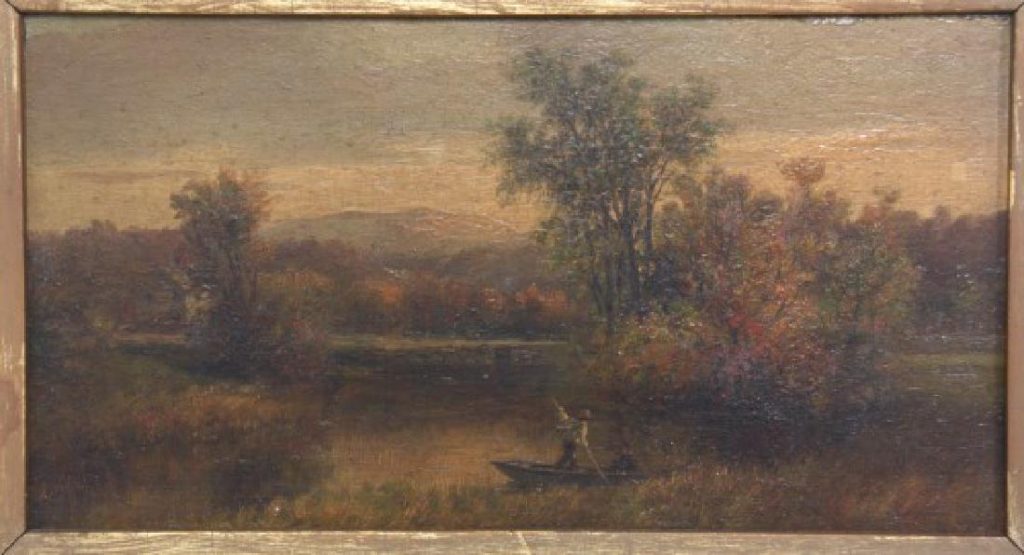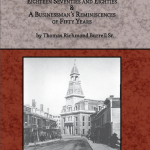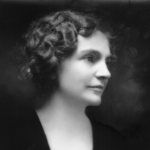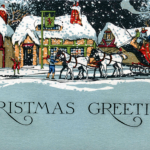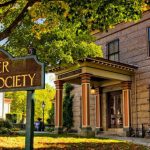In my last posting about Robert Spear Dunning’s 1885 oil-on-panel landscape painting, Autumn at Medway – acquired by the FRHS at auction in April, 2018, and recently returned from the conservator – I stated that research to document its provenance was beginning to bear fruit, and, thus far, we had been successful in documenting its sale history.
Well, I am delighted to report that things have changed.
Quite a bit, actually.
Documenting provenance can, perhaps, best be likened to detective work: It takes patience – lots of it – practicality, research, and a touch of cunning thrown into the mix. These skills, combined with genealogical and internet searches, scanning auction listings, reading obituaries, inquiries via email and telephone, and rather a bit of luck, sometimes prove positive.
Piece by piece, one attempts to add additional links to the chain of provenance, eventually forging a length that documents the full history of the object in question.
In this case, the results have been very positive and the three links that I mentioned in the last posting – two auctions and an appraisal day – have been forged into a length of chain comprised of nine links that firmly secures the past to the present.
Prior to first being consigned to auction, Autumn at Medway had appeared at a Treasure’s In the Attic appraisal day, held on June 10, 2017, and sponsored by the Townsend Historical Society in Townsend, Massachusetts; the next logical step was contacting that organization in an attempt to ascertain the identity of the individual who brought the painting to that event for evaluation. The fact that the painting had survived in its original, unrestored condition for well over a century lead me to think that it probably remained in a private family collection for considerable time. Identifying that individual would most likely help to document the history of the piece prior to its being offered at auction.
Inquiries were made, Fortuna smiled, and the response I was hoping for proved positive – far more than I could have hoped for.
My telephone message left for the Townsend Historical Society quickly resulted in a reply via voicemail: “Hi, Michael, this is Claire Kauppi, Past President of the Townsend Historical Society. I received your message and I have ….”
Interesting, that.
An immediate call back to Claire and the floodgates opened: She remembered the painting – quite well, actually – and knew that it had belonged to the former site administrator at the Townsend Historical Society.
“Let me give you her telephone number.”
One telephone call and a few emails later: Provenance established!
The painting had, indeed, descended in the same family for decades, and had a Fall River connection, although it made a bit of a detour when it passed into the collection of the descendants of a second wife in the late 1940s.
Here goes:
Autumn at Medway was acquired by:
Carrie Evalena Field née Fisher (1859-1917)
(Mrs. Lorenzo Tucker Field)
Carrie was married in Fall River and resided here; she was the daughter of Lyman Merton Fisher (1825-1911) and his wife, Lucy Jane née Borden (1835-1907).
It passed to her daughter –
Ella Gilbert Lamphere née Field (1883-1948)
(Mrs. Harry Richardson Lamphere)
After her death, the painting became the property of her husband –
Harry Richardson Lamphere (1880-1962)
Then it passed to his second wife –
Anna Margaret Wilkinson née Hayes (1885-1963)
(Mrs. Harry Richardson Lamphere)
Who left it to her daughter by her first husband –
Dorothy Griffin née Wilkinson (1914-2010)
(Mrs. George Robert Griffin)
Who bequeathed it to her son and daughter –
Griffin Family
Who consigned the painting to –
Central Mass Auctions Inc.
Worcester, Massachusetts
August 31, 2017
Where it was purchased by an unidentified individual, who, in turn, consigned it to –
Fontaine’s Auction Gallery
Pittsfield, Massachusetts
April 21, 2018
Where it was acquired by the –
Fall River Historical Society
and thus returned to a Fall River collection.
In a nutshell: The painting traveled to various family homes in Massachusetts and Maine and eventually made its way to Tyngsboro, Massachusetts, “where it was stored for decades.”
According to its last owner:
Our house was built in 1823 and had many additions throughout the 19th century. One was an ell … most of what came down from Maine was stored there; it was where my brother and I found it, stacked with other paintings on a shelf, when we cleared out that house … in 2010.
Neither my brother nor I have much storage space, and we brought several things to be auctioned … largely so they would (hopefully) land in the hands of people who truly appreciate them.
I’m delighted to know the Dunning painting will be displayed at the FRHS where it will be widely appreciated and enjoyed – and cared for. I wish I had known of the society’s interest long ago. My brother and I would have probably donated it. But – a happy ending, anyway.
By the way, the painting looks wonderful since you cleaned it! It’s quite dramatic.
Well said.
So there you have it, provenance by family descent that included several private individuals, then two auction houses, and, finally, a museum – a length of chain of nine links.
There is much that goes on behind the scenes in a historical society museum; acquisition of an object and its accession into a collection is oftentimes not the culmination – far from it, it is the beginning. To properly interpret an object – to document its historical significance for the record – takes research and time … a great deal of it.
Fascinating, work, to be sure, but daunting nonetheless, especially when one considers the vast number of objects in the FRHS collections.
But, in the case of Autumn at Medway, we have struck one off the list.


